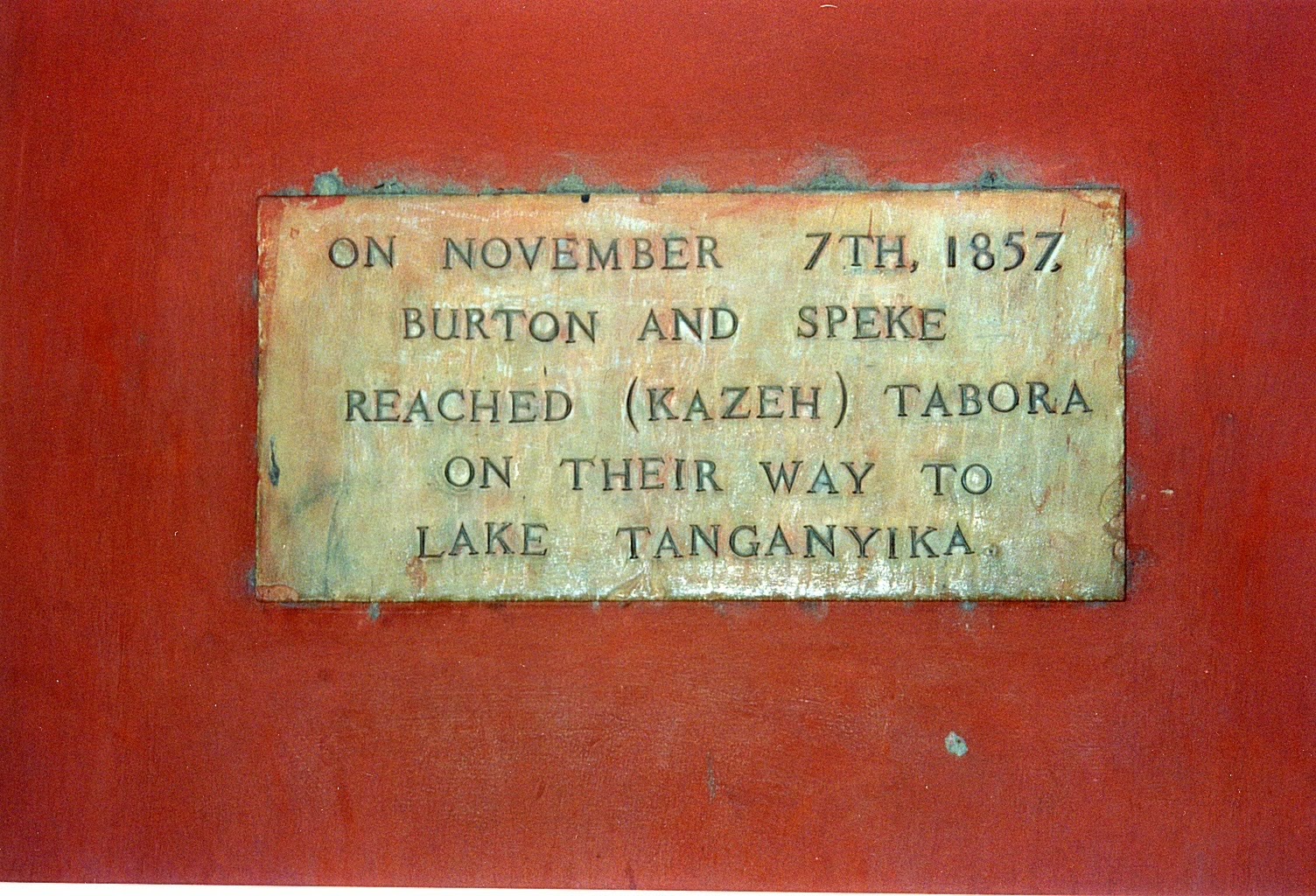BEFORE DILLON'S TIME IN AFRICA
Three Early Explorers
There were a number of early Explorers travelling in Africa. The glamorous goal for some was to be the one, the first, to discover the source of the Nile. These men knew each other and often journeyed together, though traditionally Explorers travelled alone. What reminded us of them as we, in turn, travelled around, were plaques like the one below:
Notice the date is 1857, sixteen years before Dillon arrived in Tabora.
And who were Burton and Speke?
BURTON: 1821 - 1890.
He was an
English geographer,
explorer, translator, writer, soldier, cartographer, diplomat, spy, poet, fencer, linguist. He could speak 29 languages, and he liked nothing better than to disguise himself and travel incognito, dressed like everyone around him.
He wrote books about his experiences, as well as on many other topics - on human behaviour, on fencing and on falconry. He blasted colonial policies of the British Empire, comments which were not well received by those in power. But he travelled westward from the Indian Ocean and was the first European to find Lake Tanganyika, guided along the way by local inhabitants. Burton was a Fellow of the Royal Geographical Society and was also knighted. His official title was Captain Sir Richard Burton.
And there was romance.
Isabel Arundell's family were disapproving of their daughter's beau at first - wrong religion, away too much - the usual reasons! But the romance persisted and she became Lady Burton.
The above-ground mausoleum of Sir Richard Francis
Burton and Lady Burton, shown below, is a representation of a desert tent,
its sandstone walls sculpted to resemble cloth rippling in a breeze. It would
be an unusual design to find anywhere, but it is a particularly striking
monument to find in a quiet English churchyard.
This tomb holds the two coffins of the Burtons.
For further interesting information go to: The Sir Richard Francis Burton Project
SPEKE: 1827 - 1864

Burton was excessively jealous of his partner's discoveries and tried his best to downgrade Speke.
Speke died in his thirties while climbing a wall in Britain. He reached for his shotgun, it somehow fired and the bullet found his heart. Burton used this untimely death to claim Speke had intentionally shot himself, committing suicide. For many years Speke was put down and was denied acknowledgement, while Burton was praised and received a knighthood.
A tragedy, but Speke's value is now being restored.
There is a monument to Speke in Kensington Gardens, in London
GRANT: 1827 - 1892

James Augustus Grant's name appears on plaques occasionally, too. He travelled with Speke. The combined journeys of Burton, Speke and Grant may be seen in this map:
Can you spot Speke's solo march to the great Lake Victoria, represented by a line of little blue dots?
Grant suffered an ulcer in a leg early on, and he spent much of his time being nursed back to health. He could not walk, so was carried on a stretcher. But he was a tough Scot, having been born in the Highlands, and he made it back home. He married
in 1865, and he soon settled down at Nairn, where he died in 1892. He was buried
in the crypt of St Paul's Cathedral, in London.
All Safari travellers will recognize the gazelle named after Grant, the Grant Gazelle, one of the largest of its family:







WHO'S DILLON? YOU SHOULD SAY THAT NEXT TIME CAUSE I DONT KNOW WHO HE IS SO YEH.
ReplyDeleteMaybe you should read the whole blog. Just a suggestion.
Delete